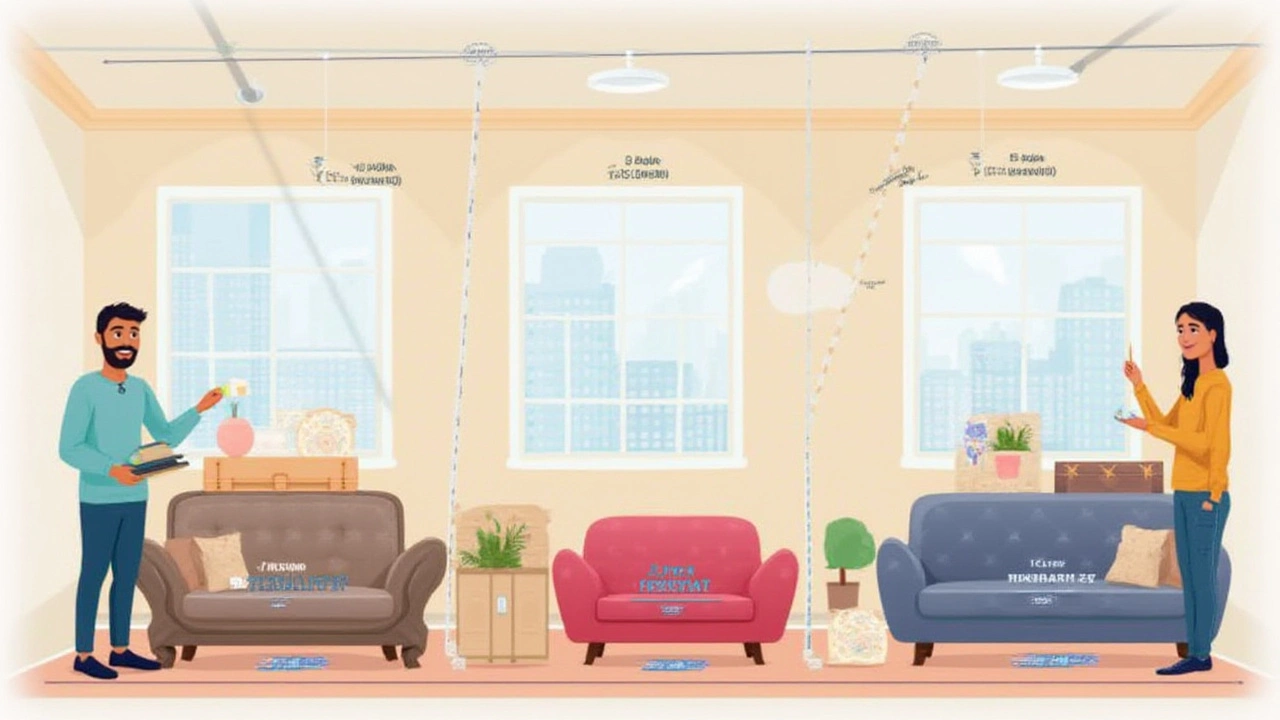You’d be surprised how many people stare at a 10x10 storage unit and wonder, “Is this thing actually big enough for my couch?” Not just any couch, but something they spent hundreds (or even thousands) picking out. Here’s the thing: inside that metal box lies more potential than you'd imagine. Whether you're moving, downsizing, or desperate to declutter, figuring out if your favorite spot to binge-watch will fit is more about smart measuring and arranging than brute force. Let's break down what 10x10 really means, how much can squeeze in beside your couch, and what rookie mistakes to dodge so you don’t end up wrestling a sofa in a rainstorm—or having to fork out for a second unit at the last minute.
How Much Space Does a 10x10 Storage Unit Offer?
If you’ve never stepped into an empty 10x10 unit, here’s what you’re facing: 100 square feet of floor space, with a typical ceiling height of around 8 feet—all told, that’s about 800 cubic feet. For reference, this is about the size of a small one-car garage or a good-sized bedroom. It’s meant to hold the contents of a two-bedroom apartment, which is saying a lot. Folks store beds, boxes, bookshelves, maybe even a washer and dryer, and yes—a couch or two.
But let’s talk numbers. The standard couch runs between 72 to 90 inches long (that’s 6 to 7.5 feet), 30 to 38 inches deep, and roughly 30 to 36 inches tall. So, let’s say you have a pretty big 7-foot sofa. Place it on its feet against the back wall, and it eats up less than 10% of your available floor space. Stand it on its end (vertical), and it takes up even less. If you’re storing a loveseat or a compact apartment sofa, it’ll only make things easier.
Of course, you don’t want to cram stuff in like a hoarder. It pays to leave a path so you can move without breaking your shins every time you need your winter boots. But if your sole concern is whether the couch can literally squeeze inside, then yes—a standard couch fits in a 10x10 with lots of space to spare for other essentials.
Actual measurements always beat eyeballing. Grab a tape measure, check your couch’s largest dimensions, and sketch out what that looks like on a 10x10 grid. Many storage companies post unit diagrams online, so snag one and compare. And here’s an often-overlooked fact: vertical stacking is your friend. That tall ceiling isn’t just for spiderwebs; it’s prime real estate for stacking boxes on top of tables or fitting your couch upright if needed. Don’t forget, though, the doorway is usually only 7 feet tall—so if your couch is enormous, angle it carefully or ask for a unit with extra height.
Types of Couches and Their Storage Implications
Not all couches are created equal. The big L-shaped sectional your cousin scored from a showroom takes up a wild amount of space compared to your college futon. Here’s what to know for the major couch types:
Standard sofa: The most common—usually between 6 and 7 feet long and about 3 feet deep. You’ll have no trouble fitting this in any way you like, even leaving room for tables or chairs. Most people find the easiest option is to stand it upright, which saves tons of floor space for all your other stuff.
Loveseat: These shorter couches (around 5 feet long) slip into a 10x10 unit with room to do a happy dance. Loveseats are a breeze if you’re squeezing in other furniture too.
Sectional: Sectionals can be beasts, but they also often break apart into manageable pieces. If yours comes apart, you can stack or “nest” the sections, filling awkward corners of the unit. But measure each segment—sometimes the chaise extension is bulkier than expected.
Sleeper sofas: Heavier and often longer than a basic couch, sleeper sofas need some muscle to move, but the frame is usually thin enough to fit upright. Just check width against the doorway.
Recliners and sofa beds: They tend to be thick and heavy. If the back can be removed or the mechanism can be wrapped to stay shut, you’ll save hassle. Always secure any moving parts to avoid surprises when you unpack months later.
There’s an old moving trick: Remove the cushions and store them separately. Not only does this save space, but it keeps the couch springs and seat from warping. If you’re storing for more than a few weeks, wrap everything in plastic to avoid dust or bugs, but don’t seal it too tight—couches need to breathe, or you risk mildew.
Lastly, don’t forget hidden snags. Some storage facilities have eccentric layouts. Ask if there’s a step at the entry, a tiny elevator, or a narrow hallway. Even if the storage unit holds your couch, getting it inside could be another story entirely.
Maximizing Your Storage Space: Pro Tips and Creative Arrangements
Cramming a storage unit isn’t about luck—it’s about strategy. Just like Tetris, every item has an ideal spot, and a little creativity pays off. Start with the heaviest and biggest stuff first, usually your couch storage. Place it at the very back, especially if it’s going to stay a while, so you aren’t wrestling with it every visit.
- Upright, if possible: Most couches, unless antique or super fragile, can stand on end. This saves precious floor area and makes it easy to slide boxes or lamps alongside.
- Nest and stack: Store lightweight stuff inside your couch frame. Chairs, laundry baskets, or lamps fit neatly under or behind. If the couch has a removable back or under-seat storage, don’t waste it.
- Break it down: If your sofa comes apart, take it apart. Less wasted space and less awkward lifting. Just keep the screws or connectors in a labeled bag taped to the underside—future you will thank you.
- Utilize vertical space: Stack lighter boxes or bins on top of tough furniture like tables or sturdy couches—but always secure for earthquakes, clumsy friends, or late-night trips when you’re half awake.
- Leave a walkway: Don’t block yourself in. Most people need to pop in and grab things from time to time. A skinny aisle down the middle means no climbing over Grandma’s lamp to get that one holiday sweater in January.
- Label everything: Seriously, don’t skip this. Once that door closes, every box looks exactly the same. Mark boxes on multiple sides, or take photos of your layout. A quick phone snapshot simplifies life later.
Got electronics? Keep them away from soft stuff in case of leaks or spills. And, keep anything you might need soon (jackets, dishes, tools) near the door. Heavy things at the bottom, lighter things on top. Not rocket science, but it saves your back and your sanity.

Common Mistakes When Storing Couches in 10x10 Units
Even veterans mess this up. Here are classic mistakes that can ruin both your couch and your storage experience:
- Not measuring first: Don’t show up with a truck full of furniture assuming you can play Jenga in real time. Always check measurements before you load up.
- Poor protection: Skipping covers or plastic wrap invites dust, pests, and moisture. But beware of wrapping too tight—sealed plastic can trap condensation, which kills upholstery.
- No air circulation: Filling a unit to the ceiling blocks airflow. That’s a fast track to musty smells and mildew. Leave an inch or two between big items and the wall, and avoid blocking vents.
- Heavy on soft furniture: Some people stack boxes right on top of couches. That’s bad news for the cushions and springs. Place heavy boxes on tables or solid frames, not on your plushy investment.
- Unsecured moving parts: Sleeper sofas, recliners, and modular pieces should be tied or taped down. Nothing wrecks a storage day faster than a sleeper frame flying open halfway through your haul.
- Ignoring the path out: If you plan to take one or two things before the end of your rental period, pack them near the door. Don’t wedge your couch against items you’ll need soon—unless you love playing furniture Tetris in a dark unit.
- Damp items: Mold loves moisture and darkness. Never store a wet couch—dry thoroughly first. Even a quick wipe before storage does wonders.
- Storing valuables or perishables: Couches can hide things, but don’t use them as secret safes. Storage units aren’t ideal for jewelry, important documents, or food that attracts pests.
Another thing nobody talks about: be ready for the day you move out. If other stuff blocks your couch, plan your exit strategy. Sell, donate, or trash what you don’t want rather than trying to squeeze in one last lamp. Remember, units are billed monthly—if you can’t get your stuff out by closing, you might eat another whole month’s rent.
Storing Other Furniture Alongside Your Couch
Most people don’t just store a couch. They have a stack of end tables, maybe a weirdly shaped lamp, definitely boxes of books or clothes. If you’re looking to save money and hassle, the goal is to fit everything in one 10x10 unit—without trashing your stuff.
Stack chairs, nightstands, dining tables, or bed frames vertically wherever possible. Most bed frames and table legs come off—take advantage of that to tuck them into tight corners. Mattresses can usually stand up on their narrow end, wrapped in plastic. If your couch is sealed in plastic, try to keep it off the floor (a cheap pallet from a hardware store works wonders) just in case of rare water leaks. Leave fragile lamps and mirrors last, tucked where they won’t get crushed—behind the couch against a side wall is a favorite trick.
If you’re mixing furniture and boxes, pack lighter boxes in the empty cavities under tables or inside bookshelves. Odd-shaped items (like floor lamps or vacuums) go in gaps along the wall. Couches can act as bumpers to shield delicate items. Some storers cut down on wasted floor space by using wire shelving for small boxes or bins—they’re easy to build and take apart, and keep your stuff organized and visible.
One shocker: A single 10x10 unit can hold a surprising amount if you break down what you can and prioritize vertical space. But all the hacks in the world won’t help if you have too much stuff. Be ruthless about what stays. If you haven’t touched it in two years, consider passing it on.
Some people add shelving or hanging racks for clothes, especially during longer storage. Racks keep textiles aired out and free from squishing. Even a simple coat rack lets you hang winter coats or dresses that shouldn’t be folded. Also, if you’re storing electronics or sensitive materials, keep them clear of the mattress and couch to avoid unwanted pressure that could lead to cracks or imprints.
For bulky dressers, keep drawers open for air flow and to avoid that weird locked-wood smell. And label everything—in big, bold letters, not just masking tape and faded sharpie.
Final Thoughts: Making the Most of Your Space
You don’t need moving company superpowers to store a couch in a 10x10 unit. With planning, measuring, and a little common sense, even that vintage sofa from your Aunt Helen can fit alongside your other treasures. The key is smart stacking, protecting against moisture and dust, and making sure nothing gets smashed or forgotten in the back corner. Go upright whenever possible, use the empty air above, and put frequently used items toward the front.
Storage units aren’t magic wardrobes, but they’re a whole lot more accommodating than they look. So if your biggest worry is whether that trusty couch will make it in, relax. Do your homework, measure everything twice, and remember: no space gets wasted with a bit of patience and a good plan.

